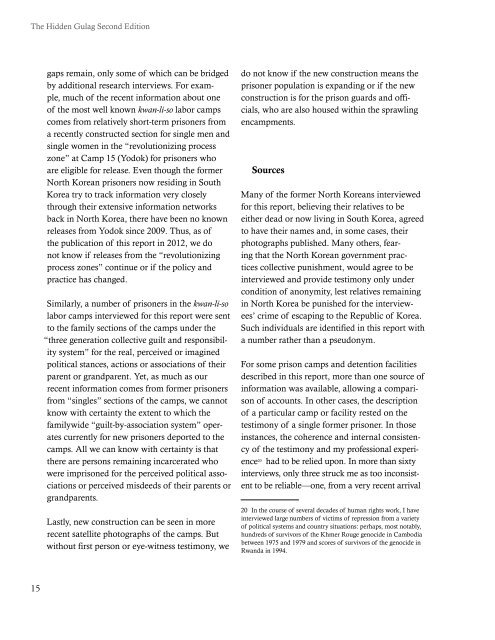The Hidden Gulag - US Committee for Human Rights in North Korea
The Hidden Gulag - US Committee for Human Rights in North Korea
The Hidden Gulag - US Committee for Human Rights in North Korea
Create successful ePaper yourself
Turn your PDF publications into a flip-book with our unique Google optimized e-Paper software.
<strong>The</strong> <strong>Hidden</strong> <strong>Gulag</strong> Second Editiongaps rema<strong>in</strong>, only some of which can be bridgedby additional research <strong>in</strong>terviews. For example,much of the recent <strong>in</strong><strong>for</strong>mation about oneof the most well known kwan-li-so labor campscomes from relatively short-term prisoners froma recently constructed section <strong>for</strong> s<strong>in</strong>gle men ands<strong>in</strong>gle women <strong>in</strong> the “revolutioniz<strong>in</strong>g processzone” at Camp 15 (Yodok) <strong>for</strong> prisoners whoare eligible <strong>for</strong> release. Even though the <strong>for</strong>mer<strong>North</strong> <strong>Korea</strong>n prisoners now resid<strong>in</strong>g <strong>in</strong> South<strong>Korea</strong> try to track <strong>in</strong><strong>for</strong>mation very closelythrough their extensive <strong>in</strong><strong>for</strong>mation networksback <strong>in</strong> <strong>North</strong> <strong>Korea</strong>, there have been no knownreleases from Yodok s<strong>in</strong>ce 2009. Thus, as ofthe publication of this report <strong>in</strong> 2012, we donot know if releases from the “revolutioniz<strong>in</strong>gprocess zones” cont<strong>in</strong>ue or if the policy andpractice has changed.Similarly, a number of prisoners <strong>in</strong> the kwan-li-solabor camps <strong>in</strong>terviewed <strong>for</strong> this report were sentto the family sections of the camps under the“three generation collective guilt and responsibilitysystem” <strong>for</strong> the real, perceived or imag<strong>in</strong>edpolitical stances, actions or associations of theirparent or grandparent. Yet, as much as ourrecent <strong>in</strong><strong>for</strong>mation comes from <strong>for</strong>mer prisonersfrom “s<strong>in</strong>gles” sections of the camps, we cannotknow with certa<strong>in</strong>ty the extent to which thefamilywide “guilt-by-association system” operatescurrently <strong>for</strong> new prisoners deported to thecamps. All we can know with certa<strong>in</strong>ty is thatthere are persons rema<strong>in</strong><strong>in</strong>g <strong>in</strong>carcerated whowere imprisoned <strong>for</strong> the perceived political associationsor perceived misdeeds of their parents orgrandparents.Lastly, new construction can be seen <strong>in</strong> morerecent satellite photographs of the camps. Butwithout first person or eye-witness testimony, wedo not know if the new construction means theprisoner population is expand<strong>in</strong>g or if the newconstruction is <strong>for</strong> the prison guards and officials,who are also housed with<strong>in</strong> the sprawl<strong>in</strong>gencampments.SourcesMany of the <strong>for</strong>mer <strong>North</strong> <strong>Korea</strong>ns <strong>in</strong>terviewed<strong>for</strong> this report, believ<strong>in</strong>g their relatives to beeither dead or now liv<strong>in</strong>g <strong>in</strong> South <strong>Korea</strong>, agreedto have their names and, <strong>in</strong> some cases, theirphotographs published. Many others, fear<strong>in</strong>gthat the <strong>North</strong> <strong>Korea</strong>n government practicescollective punishment, would agree to be<strong>in</strong>terviewed and provide testimony only undercondition of anonymity, lest relatives rema<strong>in</strong><strong>in</strong>g<strong>in</strong> <strong>North</strong> <strong>Korea</strong> be punished <strong>for</strong> the <strong>in</strong>terviewees’crime of escap<strong>in</strong>g to the Republic of <strong>Korea</strong>.Such <strong>in</strong>dividuals are identified <strong>in</strong> this report witha number rather than a pseudonym.For some prison camps and detention facilitiesdescribed <strong>in</strong> this report, more than one source of<strong>in</strong><strong>for</strong>mation was available, allow<strong>in</strong>g a comparisonof accounts. In other cases, the descriptionof a particular camp or facility rested on thetestimony of a s<strong>in</strong>gle <strong>for</strong>mer prisoner. In those<strong>in</strong>stances, the coherence and <strong>in</strong>ternal consistencyof the testimony and my professional experience20 had to be relied upon. In more than sixty<strong>in</strong>terviews, only three struck me as too <strong>in</strong>consistentto be reliable—one, from a very recent arrival20 In the course of several decades of human rights work, I have<strong>in</strong>terviewed large numbers of victims of repression from a varietyof political systems and country situations: perhaps, most notably,hundreds of survivors of the Khmer Rouge genocide <strong>in</strong> Cambodiabetween 1975 and 1979 and scores of survivors of the genocide <strong>in</strong>Rwanda <strong>in</strong> 1994.15



